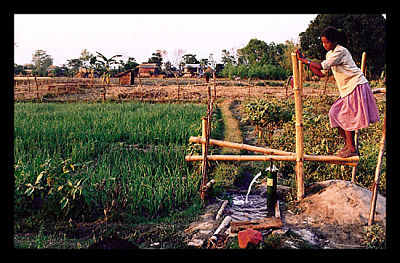Irrigation Could End Poverty

By now, it is a well known fact that clean water is necessary for drinking and hygiene. About 1.1 billion people go without clean water every day and must rely on polluted or infected supplies to survive. Even more than that go without basic sanitation. But, water is not just for human consumption and cleanliness. Access to good water can be the difference between eating and starving for rural farmers throughout Sub-Saharan Africa. In order to grow sufficient crops, farmers need water and frequently must rely on sparse rains and transporting water on their own to provide for the plants they are attempting to grow.
Only four percent of rural farmland is irrigated, even though up to 40 million hectares are proven to be appropriate for irrigation. Farming in Africa has proven to be a difficult endeavor at the best of times. Rainfall has become unpredictable and crop yield is often too low to feed a family, let alone to sell in a market. The frustrating part is that there is plenty of water available underground, but the farmers lack an affordable way to actually obtain it.
Large, centralized irrigation schemes are usually built around a major dam and were very successful, especially during the so-called Green Revolution. Millions of people were brought out of hunger as a result. But they often proved to be environmentally destructive and tend to be very expensive to build and use, especially for those living in Africa.
The answer to providing access to crop irrigation for poor rural farmers in Africa could be much smaller, like the treadle pump. The pump is used by stepping up and down with the long poles, or treadles, that activate the suction and pump water out of the ground. One family told Sandra Postel, who of the National Geographic Freshwater Initiative, that their $35 investment brought them $100 in revenue the first year they used it.
The downfall of a pump like this is that it requires a lot of physical work to use and ends up taking time away from other important activities like schooling and harvesting. Nonetheless, several companies such as KickStart have created variations of the treadle pump to help spread the use of irrigation. With their affordable irrigation pumps, KickStart has been able to help 750,000 Africans pull themselves out of poverty. Groups like FarmAfrica have gone in and taught the farmers how to use the pumps and what crops to grow to get the best yield. Until small motorized pumps are more universally available and affordable, the benefits of being able to grow enough food to eat and sell seriously outweigh the issue of having to operate to pump manually.
– Chelsea Evans
Sources: Global Issues, National Geographic, FarmAfrica, KickStart
Photo: Indiegogo
